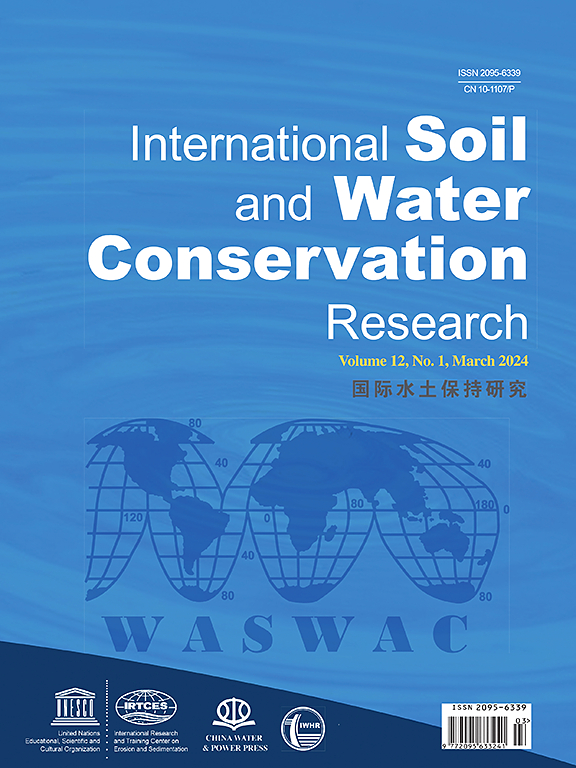Sediment source determination comparing rare earth element tracing and composite fingerprinting approaches on hillslopes
IF 7.3
1区 农林科学
Q1 ENVIRONMENTAL SCIENCES
International Soil and Water Conservation Research
Pub Date : 2025-05-20
DOI:10.1016/j.iswcr.2025.05.007
引用次数: 0
Abstract
Both the rare earth element (REE) tracing and the composite fingerprinting approaches are valuable for sediment source identification. However, few studies have compared the accuracy of sediment source determination based on these two approaches, particularly for coarse-textured soils. This study combined simulated rainfall experiments with artificial mixtures, providing validation data for sediment contribution estimation. Simulated rainfall experiments were conducted using lanthana (La2O3), yttria (Y2O3), and ceria (CeO2) separately tagged Acrisols, Chernozems, and Arenosols at 10°, 15°, and 20° slope gradients under a 120 mm h−1 rainfall intensity. Sediment from different soils during 1-h (1 h) erosion process was continuously and separately collected within a 6-min time interval. Then, artificial mixtures were created using sediment from different soils over the same collection time. Sediment contributions were estimated using bulk samples (i.e., <1000 μm) for REE tracing, while they were estimated using a series of particle size ranges (i.e., <10, 10–63, 63–125, 125–250, 250–500, and 500–1000 μm) according to the composite fingerprinting for different source soil groups (i.e., Acrisols–Chernozems, Acrisols–Arenosols, Chernozems–Arenosols, and Acrisols–Chernozems–Arenosols). Here, we also analyzed the impacts of particle correction based on REE enrichment ratio (ER) within fine particles (<10, <63, and 10–63 μm). The results showed that sediment contribution accuracy based on the bulk samples was relatively high for both fine-textured and coarse-textured soils (RMSE<13.4%) on hillslopes, with or without adopting the particle correction factor. Whereas the accuracy of sediment contributions determined using different particle size ranges greatly varied for fine-textured source soils, while all the results presented significant (p < 0.05) differences compared to those obtained using the sediment weighting approach when coarse-textured source soil was included. Moreover, particle correction based on ER values of fine particle size fractions in which REEs were mainly enriched had no obvious effects on decreasing sediment contribution estimation bias. Additionally, particle correction had a high risk of decreasing estimation accuracy of sediment contributions using both REE tracing and the composite fingerprinting approaches. For the bulk samples, ER-corrected sediment contributions were significantly different (p < 0.05) from sediment weighting and uncorrected results when a coarse-textured soil (i.e., Arenosols) was included in the source soils. This was also the case for Acrisols and Chernozems, particularly on 15° hillslopes. Clearly, both REE tracing and composite fingerprinting are useful for sediment source determination, and sediment bulk samples normally provide robust results. Additionally, particle correction is not recommended when sediments have relatively weak sorting effects.
比较稀土元素示踪法和复合指纹法在山坡上沉积物来源的测定
稀土示踪法和复合指纹法在沉积物源识别中都具有重要的应用价值。然而,很少有研究比较基于这两种方法确定沉积物来源的准确性,特别是对于粗糙质地的土壤。本研究将模拟降雨试验与人工混合试验相结合,为泥沙贡献估算提供了验证数据。利用镧(La2O3)、钇(Y2O3)和铈(CeO2)分别标记Acrisols、Chernozems和Arenosols,在10°、15°和20°坡度下进行了模拟降雨实验,降雨强度为120 mm h - 1。在6 min的时间间隔内,连续收集不同土壤在1 h (1 h)侵蚀过程中的沉积物。然后,在相同的收集时间内,使用来自不同土壤的沉积物制成人工混合物。沉积物的贡献采用块状样品(即<;1000 μm)进行REE示踪,而根据不同源土组(即Acrisols-Chernozems、Acrisols-Arenosols、Chernozems-Arenosols、Acrisols-Arenosols和Acrisols-Chernozems - arenosols)的复合指纹图谱,采用一系列粒度范围(即<;10、10 - 63、63-125、125-250、250-500和500-1000 μm)进行估算。在此,我们还分析了基于细颗粒(<10, <;63和10 - 63 μm)内REE富集比(ER)的颗粒校正的影响。结果表明,无论是否采用颗粒校正因子,基于体样的细质土和粗质土沉积物贡献精度均较高(rmse13.4%)。而在细质源土中,不同粒度范围确定的泥沙贡献精度差异很大,而在粗质源土中,所有结果都与采用泥沙加权法获得的结果存在显著差异(p < 0.05)。此外,基于稀土元素富集的细粒度组分的ER值进行粒子校正对减小沉积物贡献估算偏差没有明显作用。此外,粒子校正有降低稀土示踪和复合指纹法估算沉积物贡献的精度的高风险。对于散装样品,当源土壤中包含粗质土壤(即砂硝土)时,er校正的沉积物贡献与沉积物加权和未校正的结果显著不同(p < 0.05)。Acrisols和Chernozems也是如此,特别是在15°山坡上。显然,稀土元素示踪和复合指纹图谱对于沉积物来源的确定都是有用的,沉积物样品通常提供可靠的结果。此外,当沉积物分选效果较弱时,不建议进行颗粒校正。
本文章由计算机程序翻译,如有差异,请以英文原文为准。
求助全文
约1分钟内获得全文
求助全文
来源期刊

International Soil and Water Conservation Research
Agricultural and Biological Sciences-Agronomy and Crop Science
CiteScore
12.00
自引率
3.10%
发文量
171
审稿时长
49 days
期刊介绍:
The International Soil and Water Conservation Research (ISWCR), the official journal of World Association of Soil and Water Conservation (WASWAC) http://www.waswac.org, is a multidisciplinary journal of soil and water conservation research, practice, policy, and perspectives. It aims to disseminate new knowledge and promote the practice of soil and water conservation.
The scope of International Soil and Water Conservation Research includes research, strategies, and technologies for prediction, prevention, and protection of soil and water resources. It deals with identification, characterization, and modeling; dynamic monitoring and evaluation; assessment and management of conservation practice and creation and implementation of quality standards.
Examples of appropriate topical areas include (but are not limited to):
• Conservation models, tools, and technologies
• Conservation agricultural
• Soil health resources, indicators, assessment, and management
• Land degradation
• Sustainable development
• Soil erosion and its control
• Soil erosion processes
• Water resources assessment and management
• Watershed management
• Soil erosion models
• Literature review on topics related soil and water conservation research
 求助内容:
求助内容: 应助结果提醒方式:
应助结果提醒方式:


